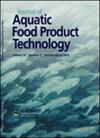Sensory Improvement of Tuna Dark Flesh for Food Application; Processing Conditions and New Meat Product Development
IF 1.3
4区 农林科学
Q4 FOOD SCIENCE & TECHNOLOGY
引用次数: 0
Abstract
ABSTRACT The abstract was corrected as follows:The sensory improvement of tuna dark flesh (TDF) and its application in meatball formulation were studied. The levels of trimethylamine, total volatile nitrogen, peroxide, and TBARS values of TDF surimi (TDFS) were decreased significantly compared to the TDF. The leaching process increased whiteness and decreased fat, myoglobin, and metmyoglobin contents, total Fe, and Heme Fe significantly. The new meat product was developed based on sensory data and consisted of 49 g/100 g beef mince and 21 g/100 g TDFS. The shelf-life study within 4-months frozen storage at −24°C indicated that the prototypes and control had similar sensory, physicochemical, and microbial characteristics within the study.食用金枪鱼黑肉的感官改良加工条件和新型肉制品的开发
摘要:对金枪鱼深色果肉(TDF)的感官改善及其在肉丸配方中的应用进行了研究。与TDF相比,TDF鱼糜(TDFS)的三甲胺、总挥发性氮、过氧化物和TBARS值显著降低。浸出过程显著提高了白度,降低了脂肪、肌红蛋白和肌红蛋白含量、总铁和血红素铁。这种新的肉制品是根据感官数据开发的,由49种 g/100 g牛肉糜和21 g/100 g TDFS。在−24°C下冷冻储存4个月内的保质期研究表明,原型和对照在研究中具有相似的感官、物理化学和微生物特征。
本文章由计算机程序翻译,如有差异,请以英文原文为准。
求助全文
约1分钟内获得全文
求助全文
来源期刊
CiteScore
3.50
自引率
6.20%
发文量
77
审稿时长
7 months
期刊介绍:
The Journal of Aquatic Food Product Technology publishes research papers, short communications, and review articles concerning the application of science and technology and biotechnology to all aspects of research, innovation, production, and distribution of food products originating from the marine and freshwater bodies of the world. The journal features articles on various aspects of basic and applied science in topics related to:
-harvesting and handling practices-
processing with traditional and new technologies-
refrigeration and freezing-
packaging and storage-
safety and traceability-
byproduct utilization-
consumer attitudes toward aquatic food.
The Journal also covers basic studies of aquatic products as related to food chemistry, microbiology, and engineering, such as all flora and fauna from aquatic environs, including seaweeds and underutilized species used directly for human consumption or alternative uses. Special features in the journal include guest editorials by specialists in their fields and book reviews covering a wide range of topics.

 求助内容:
求助内容: 应助结果提醒方式:
应助结果提醒方式:


